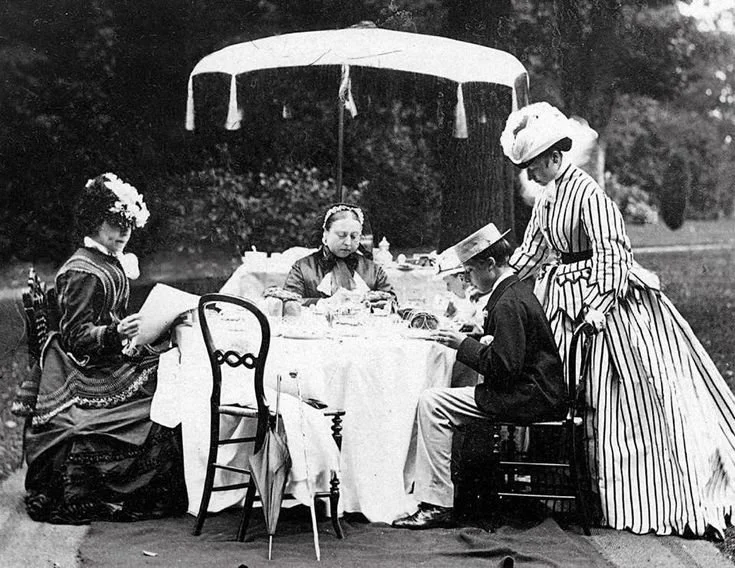The Imperial Weight of British Tea
Tea is one of Britain’s national drinks. I’d go further and say it is THE national drink. We drink a million cups of the stuff every day. But as we sip on our innocent cuppa, few of us know its dark history; how it has caused wars; exploitation; drug addiction; corporate espionage; and much more besides. My ‘Empire in a Cup : the history of tea tour’ covers some of this. But there isn’t enough time for everything. Specifically that this bitter brew is also one of the clearest examples of how colonial systems continue to shape the lives of tea workers across the world today. India, Sri Lanka and Kenya – historically three of Britain’s major colonial tea producers – remain locked into a plantation model established under East India Company and British rule. The structures created in the nineteenth and twentieth centuries are still visible today, and the legacy is most sharply felt by the people who grow and pick the tea that fills supermarket shelves in Britain.
Queen Victoria, the Empress of India, enjoying her tea. The Empire was at its height under her reign.
Tea fuelled an Empire. By the mid-eighteenth century, tea imports provided around 10% of the British government’s revenue through taxation. Tea was raising £5–6 million a year — enough to pay for two-thirds of the Royal Navy. In modern terms, that’s close to a billion pounds annually from a single commodity.
The East India Company (EIC), holding a monopoly on the China tea trade until 1833, was central to this fiscal model. But there was a problem. China would only accept silver in exchange for tea. And when silver was in short supply, the East India Company solved its balance of payments problem by forcing cheap, good quality opium, grown in British India, onto the Chinese. Drugs were exchanged for silver. Silver was exchanged for tea. This opium paid for the entirety of Britain’s tea imports with enough money leftover to reinforce the East India Company’s private army and ‘annex’ more parts of India. Even when China objected to its people being hooked on opium, the East India Company’s private military - ably abetted by the British Navy - went to war for the right to import opium. These were the Opium Wars (the first being 1839-42) which really should be called the Tea Wars, because that was what it was all about.
Over this time the EIC became increasingly desperate to break the reliance on China for tea. So in 1834, the Company dispatched George James Gordon, Secretary of its Tea Committee in India, to China. Gordon smuggled out around 80,000 tea seeds, which were cultivated at the Botanical Gardens in Calcutta. From there, seedlings were distributed to Assam, the North-East Frontier and the Himalayan foothills. Within a decade, Gordon’s mission had produced some two million bushes growing in India.
A second and more famous mission followed. In 1848, the Scottish botanist Robert Fortune travelled through China in disguise, gathering seeds, and the knowledge of Chinese tea processing. He succeeded in smuggling out 20,000 seeds. From these plants and those smuggled earlier by Gordon, Indian tea estates swept through the land.
Later, as the British Empire expanded, the Chinese tea plant was the basis for vast plantations in Ceylon (Sri Lanka), Kenya and many more. The business model was set. The colonial story of tea was replicated in each of these tea growing countries. Britain had its British tea….from the Empire.
India (Assam)
But, against all these wars and subterfuge, what the EIC had failed to understand was that tea had been growing in India under their noses all along…. in Assam. In 1821, an Indian nobleman - Maniram Barua - pointed the tea plant out to Edinburgh-born Robert Bruce, an EIC military man. And it was his brother, Charles, who subsequently spent ten years trying to persuade the EIC tea committee it was indeed tea. There were two problems. It was the wrong shaped leaf. And it was a tree not a bush. But this was the Assamica version of the Chinese plant, brought to India centuries earlier by Buddhist monks. It had just adapted itself. And remember Maniram Barua? Well you’d think the EIC would be eternally grateful to him for this discovery? Sadly not. He was later dismissed from the Assam Tea Corporation, his lands were given to Williamson tea, and after the Indian Uprising in 1857, he was hung by the British for his involvement..
In discovering tea in Assam, the first problem was that the Company wasn’t the ruler of Assam. Their ‘divide and conquer’ model just hadn’t yet reached that far. This was rectified through speedy annexation. Quickly followed by the passage of the ‘Waste Land Rules’ in the 1830s. This meant the forests in the area were declared ‘wastelands’ - never mind that Indian people were living on this land and living off it. The land was advertised to British planters (Company officers, civil servants etc.) at little or no rent, but with the promise of lucrative tea cultivation. At first leases typically ran for 45–99 years, but after that they were converted to freehold. This was a land grab by the British state, not even thinly disguised. And when those planters started to produce tea, the British government collected land tax from them which they used to fuel further expansion of the Empire. Win Win. By 1900, British firms such as Finlays and Williamson Tea controlled hundreds of thousands of acres in Assam. The plantations today are still in private hands, many of them ‘beneficiaries’ of the ‘Waste Land Rules’ all those years ago.
At the outset local populations resisted working on plantations. They were working their land themselves. No time to do anything else. Some were growing opium to sell within Assam saving a little for themselves. To ‘incentivise’ these workers, the Company banned the cultivation of opium in Assam, setting up supply from other nearby estates into Assam at vastly increased prices. Growers’ addiction did the rest. To feed their habit, the Assamese bought at higher prices, were plunged into debt, and had to seek work on the new tea plantations. The EIC had their tea pickers. Even then, the EIC’s hunger for more and more labour meant going further afield. They started to rely on labourers recruited from central and eastern India. Most labourers were coerced and, once there, they were kept in slavery-type conditions, unable to return. Their contracts criminalised “desertion,” and workers were often bound by debt to recruiters. Between a quarter and a fifth of labourers died within their first year on the plantations. Nothing changed when the British rule of India started in 1858, at the closure of the EIC. And by the early twentieth century, more than one million migrant labourers had been brought into Assam. By this time India was exporting around 200,000 tonnes of tea a year.. Many of the people working on tea plantations in Assam today are the descendants of those early coerced workers.
Assam’s forests were cleared for monocrop tea. By the late 19th century, tens of thousands of hectares of forest had been converted, destroying biodiversity and altering river systems. This landscape remains dominated by plantations today. While today, India produces over 1.3 billion kg of tea annually, with Assam contributing more than half, workers remain poorly paid. Oxfam (2019) reported that Assam pickers - mostly women - receive just 1–2% of the retail price of a packet of tea in Britain and half the living wage.
Sri Lanka (Ceylon)
It’s a similar story in Sri Lanka. In the 1840s, The East India Company passed a series of ‘Waste Lands Ordinances’ which declared much of the Kandyan Highlands to be Crown property. These lands were leased or sold cheaply to European planters, first for coffee, then when Coffee Leaf Rust killed the crop, for tea.
One million Tamil workers and their families were recruited by British tea planters from southern India between 1820 and 1900, under indenture-like systems. They became known as ‘Plantation Tamils’ and were housed in estate “line rooms”. There was high infant mortality and wages remained far below subsistence levels. This recruitment of Tamils is directly tied to Sri Lanka’s ethnic tensions and grievance by the Sinhalese population today. Indeed after independence in 1948, the Ceylon Citizenship Acts stripped many Plantation Tamils of citizenship with about 700,000 being rendered stateless because they were seen as migrants - despite generations having lived on the island. Sinhalese nationalists still see Plantation Tamils as outsiders brought by the British.
In terms of the environmental impact highland forests were replaced by plantations. By 1900, tea accounted for 46% of Ceylon’s exports and today tea plantations still dominate the central highlands.
Sri Lanka remains one of the world’s largest tea exporters, earning around US$1.2 billion annually. Wages, however, remain among the lowest in the formal sector. Plantation workers of which about 60-70% are women, are still among the poorest in the country. A woman plucker earns about £2.50 a day : the living wage if about £5.
Kenya
Building on these colonial models, in the early twentieth century, Britain again appropriated land in the so-called “White Highlands” – around 8 million acres were reserved for British settlers. Tea was introduced commercially in the 1920s, with estates concentrated in Kericho and Nandi.
Kenyan communities were pushed off their land and compelled into wage labour through hut taxes and pass laws. By 1930, large estates owned by companies such as Finlays and Williamson Tea dominated production.
Kenya’s montane forests were cleared for plantations. Tea monocultures still dominate Kericho’s landscape, with well-documented impacts on biodiversity and water resources.
Today Kenya is the world’s largest exporter of black tea, earning US$1.7 billion in 2024. Yet pickers’ wages remain extremely low with women earning 25–30% less than men. Reports also highlight risks of gender-based violence and harassment on estates: in 2023, a BBC investigation into plantations in Kericho uncovered widespread sexual exploitation. Less than 1% of the retail price of a packet of tea in Britain reaches Kenyan workers. Protests and legal cases continue against multinationals over land rights and workers’ conditions.
The British Empire created the structures that still govern the tea industry today: appropriated, imported or coerced labour in poor conditions, and monocrop plantations owned by private or corporate elites. Britain financed its global power through tea — while the producing countries were left poor.
As Britain recognises its historic role in the slave-grown sugar economy, so too it must recognise its role in shaping the exploitative structures of tea. The workers who harvest tea in Assam, Sri Lanka and Kenya are not part of a distant history. They are part of a living legacy, one for which Britain bears responsibility. When you buy your tea, take a moment. Check for that ethical mark; pay a little bit more for your tea; and know where you tea comes from, including its British history. Supermarkets pocket half of the cost of your tea. The rest is spread down the line with the pickers receiving the least. Just a 5p increase by supermarkets in the price of a pack of 80 bags could raise tea workers’ wages to meet living standards.


